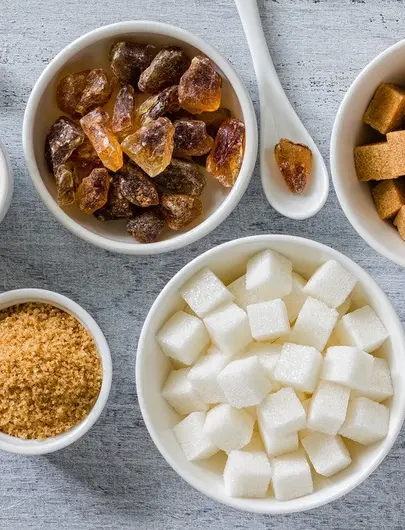Sugar has become a bit of a dirty world, blamed for a host of health issues such as obesity, tooth decay, and diabetes. The sugar-free movement has taken off in a BIG way, with many people reaping the benefits of cutting out (or at least, reducing) the sweet stuff from their diets. We’re on the sugar-free train, and we’ve never felt better!
But there’s more to going “off” sugar than just skipping that spoonful in your cup of tea. If you want to look and feel healthier, you don’t need to deprive yourself – you just have to learn how to treat yourself without the nasties. So, let’s talk sweets…
Why is sugar ‘bad’?
Sugar is a mixture of fructose and glucose that comes in a variety of forms. While sugar does provide the body with energy, any of this energy that isn’t burnt up by activity is stored as fat, which – you guessed it – affects our mood, weight and energy levels.
What types of sugars are out there?
There are a few different types of sugar. Refined sugar – that white stuff you might pour into a cake mix – is the worst of the lot. It’s highly processed, has no nutritional value, and a high Glycaemic Index. The index is one way to measure how sugars in foods affect blood glucose. The lower the number, the better for your health, as low-GI foods keep your blood sugar levels stable. As you can probably imagine, lollies, chocolates, soft drinks and the like have a sky-high GI, meaning they lift you up before sending you crashing down. Have you ever felt even more tired an hour after eating chocolate? Or been in a foul mood after guzzling lemonade? That’s why.
Now, a better form of sugar is natural sugar – like that found in fruit. While we still need to watch how much we eat, it’s a far better option than the processed stuff.
How much sugar should we be consuming?
That brings us to the big question: how much sugar can we (healthily) eat? Well, the World Health Organisation says sugar should take up no more than 10% of our diets, and Australia’s National Health and Medical Research Council puts the number at 15-20%.
Let’s break it down.
According to these stats, the average man (aged between 30-60) can consume 24-32 teaspoons a day.
The average woman can consume 19-25 teaspoons.
And this accounts for both red frogs and rockmelons – in the eyes of health organisations, sugar is sugar.
What are the alternatives to sugar?
If you’ve got a sweet tooth but are keen to cut out the traditional white stuff, we have good news! There are plenty of natural, healthier options to consider. Here are our faves:
- Stevia. A South American herb, stevia is a natural, calorie-free sweetener that sweetens foods without nasty side effects.
- Xylitol. A sugar-free alcohol that doesn’t raise blood sugar levels and has fewer calories than the traditional form of sugar. Xylitol is found in some fruits and vegetables, and is therefore considered natural.
- Rapadura. An unrefined whole sugar cane, rapadura contains a balance of sucrose, glucose and fructose, and is easier to digest and metabolise than its cousin, white sugar.
- Rice malt. Made from 100% organic brown rice, rice malt syrup contains a combination of complex carbohydrates, maltose and a small amount of glucose, but is 100% fructose-free.
- Honey. While high in sugar content, raw unheated honey (especially manuka) does contain vitamins and minerals. It has antibacterial and antioxidant properties, so using a teeny tiny bit to sweeten your tea is fine.
There is a ton of information out there about sugar – it seems everyone has an opinion on it. At GMB, we avoid refined sugar like the plague (meaning it’s not in any of the goodies in your boxes), but believe in eating natural sugar – like fruit – in moderation. Balance is the key!
Have you tried reducing the amount of sugar in your diet? How do you feel?

